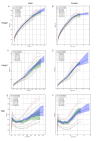Long-term safety and influence on growth in patients receiving sirolimus: a pooled analysis
- PMID: 39148107
- PMCID: PMC11325711
- DOI: 10.1186/s13023-024-03243-5
Long-term safety and influence on growth in patients receiving sirolimus: a pooled analysis
Abstract
Background: Sirolimus is increasingly utilized in treating diseases associated with mTOR pathway overactivation. Despite its potential, the lack of evidence regarding its long-term safety across all age groups, particularly in pediatric patients, has limited its further application. This study aims to assess the long-term safety of sirolimus, with a specific focus on its impact on growth patterns in pediatric patients.
Methods: This pooled analysis inlcudes two prospective cohort studies spanning 10 years, including 1,738 participants (aged 5 days to 69 years) diagnosed with tuberous sclerosis and/or lymphangioleiomyomatosis. All participants were mTOR inhibitor-naive and received 1 mg/m²/day of sirolimus, with dose adjustments during a two-week titration period to maintain trough blood concentrations between 5 and 10 ng/ml (maximum dose 2 mg). Indicators of physical growth, hematopoietic, liver, renal function, and blood lipid levels were all primary outcomes and were analyzed. The adverse events and related management were also recorded.
Results: Sirolimus administration did not lead to deviations from normal growth ranges, but higher doses exhibited a positive association with Z-scores exceeding 2 SD in height, weight, and BMI. Transient elevations in red blood cell and white blood cell counts, along with hyperlipidemia, were primarily observed within the first year of treatment. Other measured parameters remained largely unchanged, displaying only weak correlations with drug use. Stomatitis is the most common adverse event (920/1738, 52.9%). In adult females, menstrual disorders were observed in 48.5% (112/217).
Conclusions: Sirolimus's long-term administration is not associated with adverse effects on children's physical growth pattern, nor significant alterations in hematopoietic, liver, renal function, or lipid levels. A potential dose-dependent influence on growth merits further exploration.
Trial registration: Pediatric patients: Chinese clinical trial registry, No. ChiCTR-OOB-15,006,535. Adult patients: ClinicalTrials, No. NCT03193892.
Keywords: Adverse events; Physical growth; Safety; Sirolimus; Tuberous sclerosis.
© 2024. The Author(s).
Conflict of interest statement
The authors have no conflicts of interest relevant to this article to disclose.
Figures



References
-
- Lai Z-W, Kelly R, Winans T, Marchena I, Shadakshari A, Yu J, et al. Sirolimus in patients with clinically active systemic lupus erythematosus resistant to, or intolerant of, conventional medications: a single-arm, open-label, phase 1/2 trial. Lancet. 2018;391(10126):1186–96. 10.1016/S0140-6736(18)30485-9 - DOI - PMC - PubMed
-
- Martin-Broto J, Redondo A, Valverde C, Vaz MA, Mora J, Del Garcia X, et al. Gemcitabine plus Sirolimus for relapsed and progressing osteosarcoma patients after standard chemotherapy: a multicenter, single-arm phase II trial of Spanish Group for Research on Sarcoma (GEIS). Annals Oncology: Official J Eur Soc Med Oncol. 2017;28(12):2994–9.10.1093/annonc/mdx536 - DOI - PubMed
Publication types
MeSH terms
Substances
Associated data
Grants and funding
LinkOut - more resources
Full Text Sources
Medical
Miscellaneous

